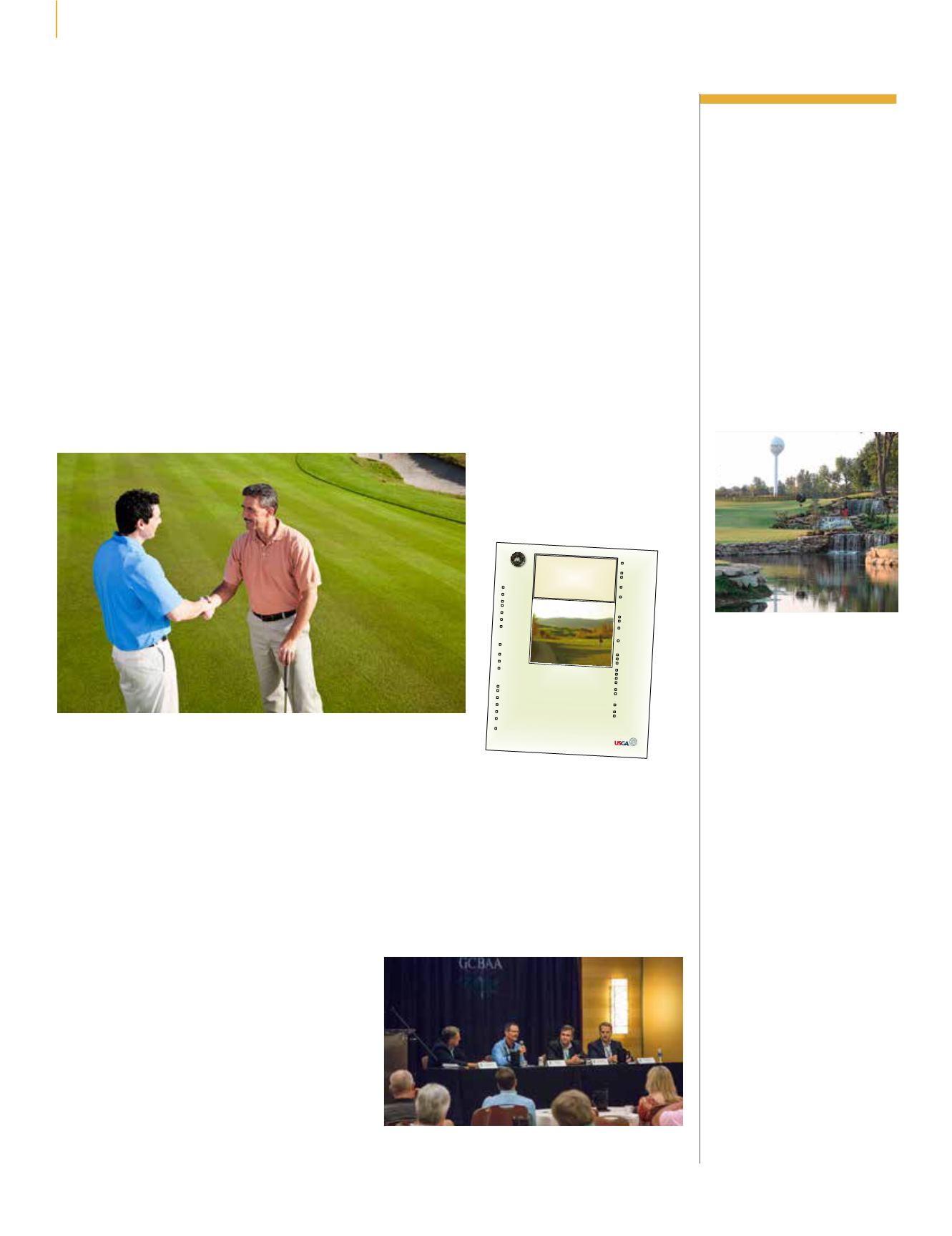
T
he ASGCA has–in
cooperation with
the United States
Golf Association–
produced a checklist and
tips for clubs working with
a golf course architect to
improve pace of play.
The guidance identifies
five basic ingredients
that contribute to
getting courses to move
faster–and smoother:
player abilities; course
management; set-up;
maintenance and turf
conditions; and course
design–the key variable
that sets it all in motion.
The goal of pace of
play initiatives–which
are now being tackled
by all of golf’s major
organizations–is to create
an even flow of golfers
as they play the game,
minimizing waiting times
and creating a more
enjoyable experience.
Members of the ASGCA
are uniquely qualified to
assist course owners and
operators with pace-of-play
improvement, while also
preserving the spirit of the
game–to make sure that
courses offer the fun and
challenging aspects that
keep golfers coming back.
The ASGCA’s Pace of Play
flyer is available as a free
download via
.
DIGEST
Helping clubs increase speed of play
ASGCA at golf builders’ meeting
Pace of Play flyer
GCBAA Meeting
ASGCA President Lee Schmidt led
an ASGCA contingent to the Golf
Course Builders Association of America
meeting, held in August 2014 at the PGA
Championship in Louisville, Kentucky.
Schmidt moderated a panel that addressed
seed and sod technology and inventory.
Joining him were Jacklin Seed’s Rick Elyea,
Atlas Turf’s John Holmes and West Coast
Turf’s John Marman. The group agreed that
supply is tight, as farms can make more
money with other crops right now, and many
turf farms were lost during the recession.
Schmidt also presented an ASGCA update
to attendees. Among other items, he noted:
“A recent survey found that 96.5 percent
of ASGCA members are designing new
courses in a way that conserves water and,
when possible, uses alternative sources of
water. And nearly 83 percent are advising
clients on the relationship between
turfgrass selection and water consumption,
and even renovating golf courses for
installation of more effective grasses.”
Inverness completes
regrassing project
Shawn Smith, ASGCA of
Hills & Forrest has overseen
the completion of a
12-month project to regrass
the playing surfaces at the
Inverness Club in Toledo,
Ohio. The project reduces
the need for fungicide
applications and restores
the greens to the shapes
originally designed by
Donald Ross.
Shangri-La renovation
project completed
The 27-hole Shangri-La Golf
Club in Monkey Island,
Oklahoma has officially
reopened following a
two-year redesign project
overseen by Tom Clark,
ASGCA Past President.
Work on the Heritage
and Legends nines was
conducted in phases so
that at least 18 holes were
available for play at all
times during the renovation.
Rogers hired for renovation
project at Pine Lake
Drew Rogers, ASGCA
has been hired to carry
out a renovation project at
Pine Lake Country Club in
Orchard Lake, Michigan.
The architect has used
aerial photography from the
1930s to help restore the
design intentions of original
architect Willie Park Jr.
05
Pace
of
Play
CHECKLIST
&
TIPS
for working with your
COURSE ARCHITECT
A. InitialSteps to
SizingUp the Issues
ofPaceofPlay
What type of course
do you operate?
What type of golfers
(Hcps.) do you cater to?
Cart/Walking policies
What are your current
round times?
Are round times
consistent— or varied?
What is your idea
of an ideal round time?
Where are the bottle-
neckson your course?
B.UnderstandingSite
Constraints
How set-in-stone is
your routing and course
footprint?
Is there any room for
change and adjustment?
Quantify the grade and
site constraints
Quantity soil types,
vegetation and firmness
C.TheDesign Intent
of theCourse
History and legacy
Identify the essential
design characteristics
How does the design
dictate set-up?
How does the design
dictatemaintenance?
Does the design limit
flexibility (tees, lengths)?
What changes to the
design intentwould be
possible and beneficial?
What type of golfers
(Hcps.) do you cater to?
AmericanSociety
of
GolfCourseArchitects
D.Routing&Sequence
Does the current
routing pose any routing
obstacles?
Where are the issues?
Does the par order and
lengths of holeswork for
(or against) good pace?
Are their solutions that
may not involve physical
change? (Easy fixes)
What are some ideas
thatmay be“thinking out
of the box”?
E.CourseSet-up,
Length&Flexibility
Is tee flexibility ample?
Is there a tee use policy
and away to enforce it?
Are there solutions
to set-upwherewait
times can be reducedor
eliminated?
Have you implemented
Tee It Forward tools?
F.CourseConditions
Greens speeds
Rough heights
Tall grasses,and their
proximity to frequent play
Fairwaywidths
Hazard difficulty
Forced carries
Tree overgrowth
(blind areas,visibility)
Hole locations
Firmness,roll, lies
G.Follow-up
Master planning relative
to Paceof Play solutions
Turf area evaluation
Tee addition planning
Produced in cooperation
with theUnitedStatesGolf
Association
P
aceofPlayhasbecome ahousehold term in golf.Whatwas
once regarded as“something only the group ahead could solve” isnow
being tackledby all of golf’smajor organizations.
Themembers of theAmericanSociety ofGolfCourseArchitects
(ASGCA) areuniquelyqualified to assist course owners and operators
in improvingpace ofplay at their facilities.Gettingplayers tomove
faster—
and smoother
— involvesfivebasic ingredients:
(1)Course design—The key variable that sets it all inmotion.
(2)How the course is beingmanaged (e.g., the starting time interval,
sequencing at thefirst tee,assisting players,etc.)
(3)Course set-up (e.g., tee flexibility,hole lengths,hole placement,etc.)
(4)Maintenance andTurfConditions (green speeds, rough heights,
tall grasses,visibility,etc.)
(5)Player abilities,and the varying types of players on a course at any
given time.
The goal is to create an even flow of golfers as theyplay the game,
minimizingwait times and creating amore enjoyable experience.
YourGolfCourseArchitect alsohas the goal ofpreserving the spirit
of the game— tomake sure that your course offers the fun and chal-
lenging aspects that lurepeople toplay time and time again.
Formore information visit:
©
2014ASGCA
ASGCA President Lee Schmidt (left) participated in
an expert panel discussion at the meeting


